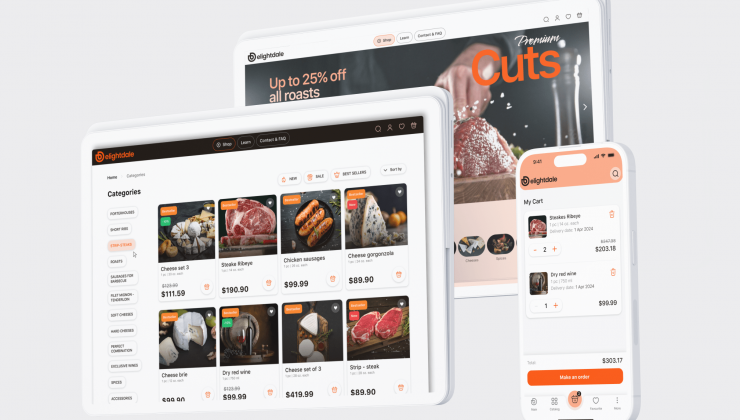Such articles typically begin with an explanation of terms and the relevance of the topic (“In modern business, B2C ECommerce Development plays a key role. Online shopping is becoming increasingly popular…”).
However, we have decided to take a different approach. We aim to make this text as useful as possible for those seeking specific solutions and who have questions about technical aspects, marketing, and practical implementation of a project.
Nevertheless, we will allow ourselves a bit of indulgence in terms of statistics, simply to clearly demonstrate the market volumes and growth rates being discussed.

As you can see, the figures are growing at a rate reminiscent of LeBron James making a three-pointer. Therefore, without a doubt, your business will gain powerful competitive advantages and new growth opportunities by implementing a B2C eCommerce solution. But first, let's delve into the types and classifications of these solutions.
What are the types of B2C ECommerce?
Usually, when we talk about "Business to Consumer ECommerce," we imagine an online store that sells retail goods of its own production or other products under its own brand.
Based on this premise, we can identify five main types of B2C ECommerce applications:
- Classic online stores.
- Marketplaces (platforms where various sellers can offer their products).
- Mobile applications (mCommerce), adapted for smartphones and tablets.
- Social commerce applications (sCommerce), such as Facebook Marketplace, Instagram Shopping, Pinterest Shopping.
- Software as a Service (SaaS). These are often used as B2B solutions in the form of Cloud-Based eCommerce (a business model in online sales where all necessary components - servers, software, storage systems, and network infrastructure - are hosted in a remote data center and provided to the seller on a rental basis).
In addition, we can classify B2C ECommerce platforms by the type of needs they fulfill: subscriptions to goods/services, flash sales, bookings, educational platforms, and food delivery services. Speaking of the latter...
B2C eCommerce Services: Our Experience
Our team has numerous outstanding case studies and over 20 years of experience in the ECommerce niche, including B2B projects. However, it is now appropriate to share the story of how we created a comprehensive eCommerce system for a client in the food industry.

The client, DelightDale (a fictional name, due to NDA), approached us after reading one of the articles on our blog. They were particularly impressed with the elegant solutions provided by our designers and UI/UX specialists. This was a critical factor in their decision to choose our development team for their project: selling premium products.
As a result, we created the following for DelightDale:
- An online store that, in essence, serves as a space for aesthetic pleasure for customers;
- A cross-platform mobile application (based on a single backend);
- A user-friendly admin panel with Customer Relationship Management (CRM) support;
- A personalized product search and recommendation system based on artificial intelligence.
The client was pleased with the quality and speed of development, but they particularly noted how accurately the team identified and addressed the needs of their target audience (more on this later). The application quickly gained high ratings and positive reviews.
You can read about this Case here:
But let's get back to the classification.
Comprehensive Solutions in the B2C eCommerce Business
Very often, B2C ECommerce website development involves not only creating an online page with a product catalog and the ability to purchase items but also many systems for organizing management:
- Customer Relationship Management (CRM);
- Content Management System (CMS);
- Business Process Management (BPM) for automation, monitoring, and analysis;
- Enterprise Resource Planning (ERP) to integrate various business aspects (finance, production, procurement, warehousing, human resources) into one platform;
- Project Management (PM);
- Document Management System (DMS);
- Human Resource Management (HRM), and others.
Therefore, a Business to Consumer platform should be viewed as a comprehensive solution that significantly impacts not only your brand's market position or the reach of your target audience but also the organization of all internal business processes.
Popular Revenue Models
When choosing a B2C ECommerce strategy, it is also important to address the financial aspect.

Some of the most popular revenue models (in addition to direct sales, of course) include:
- Subscription: Customers pay a regular subscription fee for access to products or services provided by the store. For example, Netflix operates this way. It can also be a one-time annual payment or full access, as with apps in the Apple App Store.
- Advertising: Charge for advertising space on your B2C marketplace. Examples include Facebook and CNN.
- Commission: A B2C business model where a percentage is taken from each transaction made through your platform. This is how eBay and Etsy operate.
- Fee: In this monetization approach, sellers must pay a fixed amount to list their products on your web resource.
- Freemium model: Basic services are provided for free, but premium features are charged, as seen with Evernote.
As you can see, B2C ECommerce web applications can be classified in numerous ways. It is important to carefully study all the options and choose the model that best fits your business.
However, you can also consult an expert, who will quickly and accurately select the optimal option for your business needs and project goals. We will consider market conditions and niche specifics, understand the needs of your target audience, and develop a strategy for scaling.

B2C ECommerce Development: from Scratch or Ready-made Solutions?
Continuing with the topic of money, let's discuss what will most impact the cost of your final product — the choice of development model. There are three main models:
- Developing from scratch: Provides full control over design, functionality, and performance, ensuring the needed flexibility.
- Ready-made solutions: For example, creating an online store using tools like Shopify or BigCommerce. This category also includes self-hosted platforms, i.e., software that is installed and runs on the user's own servers rather than those of a third-party provider, such as Magento and WooCommerce.
- Partial implementation of SaaS components: Using third-party tools to meet specific needs, such as email marketing, logistics, or accounting.
Let's compare their features, advantages, and disadvantages in a table:
|
Criterion |
Custom Development |
Ready-made solutions |
Partial implementation of SaaS components |
|
Cost |
High initial cost |
Low initial cost, monthly payments |
Medium |
|
Development Time |
Long (months) |
Fast (weeks) |
Medium |
|
Flexibility and Customization |
Maximum |
Limited |
High |
|
Maintenance and Support |
Self-managed |
Included in the cost |
Self-managed |
|
Updates and Security |
Depends on the developer |
Automatic |
Regularly required |
|
Scalability |
High |
Within the platform |
High (depending on architecture) |
|
Integrations |
Easy integration of any systems |
Limited to provided integrations |
High, but requires technical knowledge |
|
Risk of Platform Dependency |
None |
High (dependence on SaaS provider) |
Medium (dependence on chosen software) |
As you can see, the options offer different levels of control, costs, and capabilities. Ready-made solutions do not provide flexibility, the ability to scale freely, and generally, they rarely meet all the needs of medium and large businesses.
Only a personalized approach will allow your B2C ECommerce marketplace to become a market leader, stand out among competitors, and meet the demands of your target audience.
Customer expectations of the B2C ECommerce experience
A couple of years ago, we could have said that clients expected a simple and intuitive interface, convenient search, filters in the catalog, and so on. But consumer preferences are changing in line with technological innovations. Providing just "good service" essentially means losing the market before the fight even begins.
So what do clients REALLY want, and what will make their user experience unforgettable?
Real personalization
Based on AI and machine learning. For example, while working on DelightDale (the premium products online store mentioned earlier), our specialists analyzed user queries and their shopping carts and realized that when a customer searches for steak, they do NOT want to see only steaks in their recommendations.
It is much more effective to suggest a bottle of aged red wine and a fine cheese as additions to their dinner. In other words, the system should provide the customer with genuine consultation on all matters and encourage additional purchases.
New experiences
For example, through augmented or virtual reality. A notable example is Nike Fit's AR functionality, which allows customers to scan their feet using their smartphones to accurately determine their size and choose the most suitable footwear.
Data security
When entrusting a platform with their addresses, phone numbers, and credit card information, the last thing users expect is for their personal information to be leaked online. Annual scandals around Amazon highlight the need for continuous improvement in security measures. Security comes first. Period.
Gamification
One of the most powerful techniques for increasing sales is promotions and discounts. And not just on Black Friday or during seasonal sales. Users expect pleasant bonuses for their loyalty, engagement, and trust year-round. At the same time, a global sale without a reason seems quite dubious: "Are you just getting rid of stock that's been sitting in the warehouse?"
A great option that also boosts engagement and positively impacts the user experience is gamification. Users love games that also offer savings. Take a cue from Shein.
Support
A well-configured chatbot can sometimes be more effective than a manager. About 40% of consumers prefer to interact with chatbots rather than live agents when shopping online. According to Gartner forecasts, by 2025, 70% will prefer to interact with artificial intelligence.
The Problems of B2C eCommerce Stores
If the benefits of B2C eCommerce are more or less clear, the issues deserve separate discussion. One of them, as you might have guessed, is security. But there are several other challenges as well:
- Competition. The market is highly saturated, and businesses have to constantly compete for consumers' attention and wallets. This often leads to price dumping and low profitability.
- High Customer Acquisition Costs. Retaining existing users is cheaper than acquiring new ones.
- Technological Race. Web applications need to be fast, reliable, and easy to use. However, they also need to be modern and adapted to changes in consumer preferences.
- Ensuring Quality Logistics. Consumer expectations for fast delivery continue to rise, putting pressure on logistics chains. High costs for shipping and returns can reduce business profitability.
- Challenges in Inventory Management. Errors in demand forecasting can lead to excess inventory in the warehouse or shortages during peak periods. This necessitates the integration of various inventory management systems, which can be complex and costly.
- Returns and Exchanges. The high rate of returns and exchanges, particularly affects the fashion industry. Companies are forced to continually increase operational expenses.
Are you looking for a reliable development team for your B2C E-Commerce Platform?
What others call "Problems," we call "Challenges":
- We implement advanced encryption technologies and conduct regular security audits to protect customer data.
- We integrate reliable and efficient logistics solutions to ensure fast and cost-effective delivery.
- We create unique and engaging interfaces, enhance user experience, and apply cutting-edge marketing strategies to make your business stand out from the competition.
- We implement SEO and SMM strategies aimed at increasing visibility and attracting your target audience.
And we can also assist you with a hundred other challenges in the eCommerce niche and beyond. Just describe your task— we'll find the most effective solution!

